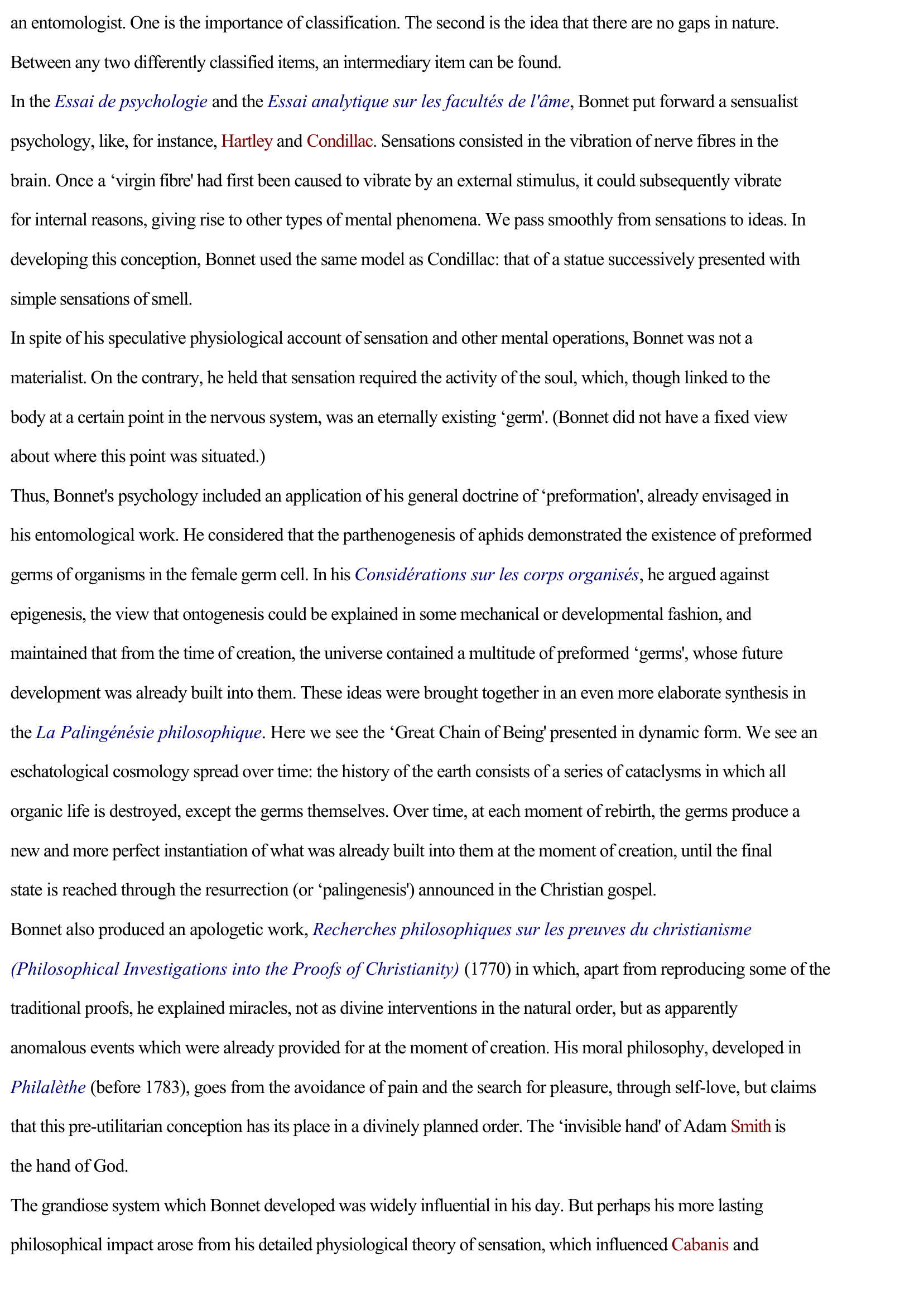Bonnet, Charles
Publié le 22/02/2012

Extrait du document
«
an entomologist.
One is the importance of classification.
The second is the idea that there are no gaps in nature.
Between any two differently classified items, an intermediary item can be found.
In the Essai de psychologie and the Essai analytique sur les facultés de l'âme , Bonnet put forward a sensualist
psychology, like, for instance, Hartley and Condillac .
Sensations consisted in the vibration of nerve fibres in the
brain.
Once a ‘virgin fibre' had first been caused to vibrate by an external stimulus, it could subsequently vibrate
for internal reasons, giving rise to other types of mental phenomena.
We pass smoothly from sensations to ideas.
In
developing this conception, Bonnet used the same model as Condillac: that of a statue successively presented with
simple sensations of smell.
In spite of his speculative physiological account of sensation and other mental operations, Bonnet was not a
materialist.
On the contrary, he held that sensation required the activity of the soul, which, though linked to the
body at a certain point in the nervous system, was an eternally existing ‘germ' .
(Bonnet did not have a fixed view
about where this point was situated.)
Thus, Bonnet's psychology included an application of his general doctrine of ‘preformation' , already envisaged in
his entomological work.
He considered that the parthenogenesis of aphids demonstrated the existence of preformed
germs of organisms in the female germ cell.
In his Considérations sur les corps organisés , he argued against
epigenesis, the view that ontogenesis could be explained in some mechanical or developmental fashion, and
maintained that from the time of creation, the universe contained a multitude of preformed ‘germs' , whose future
development was already built into them.
These ideas were brought together in an even more elaborate synthesis in
the La Palingénésie philosophique .
Here we see the ‘Great Chain of Being' presented in dynamic form.
We see an
eschatological cosmology spread over time: the history of the earth consists of a series of cataclysms in which all
organic life is destroyed, except the germs themselves.
Over time, at each moment of rebirth, the germs produce a
new and more perfect instantiation of what was already built into them at the moment of creation, until the final
state is reached through the resurrection (or ‘palingenesis' ) announced in the Christian gospel.
Bonnet also produced an apologetic work, Recherches philosophiques sur les preuves du christianisme
(Philosophical Investigations into the Proofs of Christianity) (1770) in which, apart from reproducing some of the
traditional proofs, he explained miracles, not as divine interventions in the natural order, but as apparently
anomalous events which were already provided for at the moment of creation.
His moral philosophy, developed in
Philalèthe (before 1783), goes from the avoidance of pain and the search for pleasure, through self-love, but claims
that this pre-utilitarian conception has its place in a divinely planned order.
The ‘invisible hand' of Adam Smith is
the hand of God.
The grandiose system which Bonnet developed was widely influential in his day.
But perhaps his more lasting
philosophical impact arose from his detailed physiological theory of sensation, which influenced Cabanis and.
»
↓↓↓ APERÇU DU DOCUMENT ↓↓↓
Liens utiles
- BONNET Charles : sa vie et son oeuvre
- ESSAI ANALYTIQUE SUR LES FACULTÉS DE L’AME de Charles Bonnet (résumé)
- Histoire de Charles Ier (extrait) L'exécution de Charles Ier François Guizot Le plus profond silence régnait ; il mit sur sa tête un bonnet de soie, et s'adressant à l'exécuteur : " Mes cheveux vous gênent-ils ?
- Charles Bonnet
- Bonnet, Charles - philosophie.

































